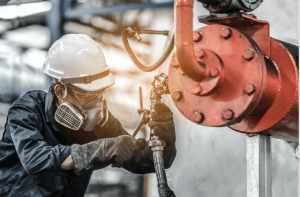Since the Covid-19 pandemic unfolded in 2020, the operators of chemical plants around the world have had no choice but to slash maintenance budgets as they grapple to adapt to new challenges, including strict social distancing measures put in place to protect a global workforce.
Such budget cutting could, however, create conditions that result in equipment failure, asset downtime and critical health and safety issues arising, all of which risk the creation of hazardous and life-threatening working environments for the personnel who continue to carry out essential work at these facilities. The effects of significantly decreased spending plans can be seen across refining, petrochemical and manufacturing facilities, and onshore assets.
The pandemic has not just impacted maintenance budgets, either. It has also limited workforce capacity as well, restricting the hundreds and thousands of contractors typically drafted in to support major maintenance programs.
Combined, these circumstances have created a critical backlog in maintenance tasks — one that could result in equipment failure, asset downtime and critical health and safety issues.
Assessing priorities
A key factor driving maintenance-related risk is that many facilities operate with a legacy maintenance strategy and plan. Often, these strategies have not been updated in-line with changing production, commercial realities and the lifecycle of the asset.

Figure 1. To minimize risks, maintenance strategies should be kept up-to-date with the latest information on asset criticality, asset lifecycle and production requirements
Information on asset criticalities maybe out of date or incomplete, resulting in a lack of data on key equipment. The result is that generic maintenance is performed at time-based intervals, often based solely on the recommendations of original equipment manufacturers (OEMs).
This results in excessive backlog, or worse inappropriate maintenance (or lack thereof) on critical equipment, leading to key maintenance tasks being delayed or, in some cases, not performed at all. This can increase the possibility of unforeseen equipment breakdown, impacting production performance, cost and safety.
When it comes to maintenance programs, asset operators frequently have to make decisions regarding essential versus non-essential maintenance. While the aforementioned OEM recommendations can help, on their own, they can also lead to unnecessary maintenance burdens, and place significant pressure on asset teams and operational budgets.
Consider your car as an example. How often do you change the oil? While all vehicle owners know this is important to a car’s health, failing to do it on time could void your warranty. But who decides what “on time” means? And doesn’t this depend on a range of factors? For instance, what is the age of the car, the type of oil you use and the driving conditions in which you use it?
Looking back, when the market was buoyant and social distancing had not yet been introduced, the industry was habitually very reactive to maintenance issues because it could afford to be. This age-old problem of, effectively, throwing money at a problem — due to the pressures of sustaining uptime and maintaining production — is a costly strategy. Such a strategy can impact other equipment and workflows, and require more non-productive time to resolve. Today, the industry cannot afford this approach.
It is known from experience, for example, that as much as 40% of maintenance work carried out by some asset operators is unnecessary. On average, operators could be spending 500 man-hours per specific equipment group (such as an electric motor supporting a compressor or a centrifugal pump) on maintenance activities that fail to reduce the risk of failure or preserve facility uptime.
To improve maintenance effectiveness, the identification and prioritization of critical assets is crucial. Furthermore, it is valuable to highlight those areas where criticality can be combined with an asset’s operational data to establish appropriate maintenance plans and map out the frequency of inspections and upgrades.
The time freed up by reducing unnecessary repairs can then be used to focus on critical equipment instead. As well as reducing maintenance backlogs, this can also have a positive impact on cost, safety and productivity.
Carrying out the appropriate amount of maintenance at the appropriate time also means putting fewer personnel at risk for harm, and avoiding the introduction of maintenance-driven equipment “infant mortality,” where equipment fails shortly after maintenance is performed.
A change of approach is needed
The key to being able to understand and optimize maintenance is data. By leveraging data, engineers gain a better understanding of equipment, including its history, usage and variables, such as corrosion, vibration, failure and consequences. Armed with these insights, plants can predict, plan for and mitigate failure.
There is a perception that it can be both time-consuming and costly to ensure that maintenance strategies fit commercial and safety objectives, while also complying with the expectations of the regulator, but this is a myth that practice has disproved.
For example, consider the cases of two chemical refineries that were successful in reducing their maintenance burdens by 25 to 40%. This was achieved by evaluating the maintenance programs on their pressure-relief devices, across the entire refinery. The benefit of this approach is that, while the overall maintenance burden is reduced, the operator can look beyond reducing the amount of maintenance required, and instead prioritize appropriate maintenance at appropriate levels.
By taking into account operational metrics, as well as reviewing equipment criticality and reliability, maintenance teams are able to free up precious resources by focusing on the so-called “maintenance-hungry bad actors” within groups of equipment. This enables engineers to look at the equipment most likely to fail, identifying root causes and establishing a more appropriate maintenance strategy, for example.

Figure 2. An effective maintenance strategy will enable plants to focus on those pieces of equipment that are most likely to fail without wasting effort on less-effective maintenance tasks
What this shows is that the cycle of money and vital resources being wasted on potentially non-essential maintenance work can, and must, be broken. By adopting a risk-based, data-centric approach, operators can prioritize maintenance and reduce the growing backlog, whilst ensuring the safety of their people and the performance of their assets.
The challenge for chemical plants and refineries
The downstream chemical processing and petroleum refining industries are an essential link in the supply of products to the end customer. It goes without saying that the manufacturing performance of refineries is connected to their customers receiving their orders on-time and in-full. Therefore, their asset performance must meet the challenge of being available and reliable for production as scheduled to fulfill the plant’s operating goals. Any disruption to day-to-day operations as a result of faulty equipment could be catastrophic for production and cause havoc in the supply chain.
Shareholder value creation and competition drives tighter margins and places increased pressure on operations and maintenance budgets. How asset care is executed impacts productivity and costs, and therefore a comprehensive asset care strategy is vital to optimize reliable equipment design and execute care from design to retirement. Taking into consideration the equipment lifecycle needs and resources available at each site, an asset care strategy determines how effective and efficient equipment care must be executed.
These strategies are often far from completely developed and ineffectively executed at many sites. Many sites are reliant on reactive care from a lack of focus on eliminating failure. The causes of this reactive strategy include lack of training, parts, care tasks, work practices and longterm discipline.
A way forward
Above anything else, it is essential that asset operators understand the importance of building reliability into their equipment during the design, construction and installation phases of the lifecycle. To do this effectively, work practices and processes should be integrated during the capital investment phases. However, often, there is an opportunity to improve performance once the assets have their power turned on.
During this operational phase, the asset operator or plant owner should implement benchmarked best practices for predictive, preventative, protective, operational and material management tactics to ensure both high availability and high reliability of their equipment.
To be successful, however, the operator or plant owner must first assess the opportunities that exist to meet their role in the supply chain. It is important to recognize how equipment performance gaps can be translated into financial impacts for the business. Improved uptime can then be leveraged to improve market share, optimize labor utilization, and modify production schedules. This can be very powerful for the business, as it directly impacts the bottom line to create shareholder value.
An expert in maintenance and reliability will be able to then support the plant operator in evaluating the current performance of both their maintenance and operations across the organization. At this stage, key metrics should be examined, such as downtime for critical assets, mean time to repair, mean time to failure, preventative maintenance compliance, and so on.
Although in these times of COVID-19 restrictions, key personnel can be remotely interviewed, maintenance systems reviewed, as well as the maintenance execution performance reviewed. They can then assess asset-care gaps from benchmarked practices across multiple equipment groups and manufacturers, promoting the detection of the early signs of failure. This can include the use of condition-based tools, such as vibration, thermographic, oil, strobe, and ultrasonic analysis. It is especially important to interview operations personnel on their role in caring for the equipment as an effective partnership between operations teams and maintenance teams is vital in reducing downtime, which is the costliest impact when it comes to equipment failure. This includes the quality of the startup, run-time and shutdown procedures. This allows for the plant operator to create a strategy for determining, analyzing and reporting failures, which suits the entire business across all teams.
If these activities are followed correctly with the right support, the operator can develop a business case with attractive returns. The returns are based on how uptime can be converted into financial opportunities through improved productivity and the reduction of significant costs.
Looking at a longer-term strategy, the operator can then improve their asset-care strategies by creating and revising preventative maintenance plans, as well as developing weekly inspection lists that focus on the early detection of defects and potential equipment failure.
In some instances, it is appropriate to review storeroom inventories to determine if the critical equipment parts are in stock and the quantities are sufficient based on the data that depict their failure history. Importantly, many of these processes can be done remotely after the maintenance data and documentation from the site have been collated, which keeps personnel safe and allows for social distancing.
Criticality is key
Criticality plays a key role in understanding how lean resources are utilized for the most important assets. Generally, 20% of a site’s assets are critical, due to safety, health, environmental, productivity, quality and maintenance cost considerations. Worryingly, however, many asset operators have failed to take the time to determine the criticality of their assets because of other pressures they face.
Criticality lists are important. At this final stage, the operator can develop critical equipment lists using industry-benchmarked procedures and processes, and these can be completed remotely. These can be used to prioritize maintenance work, determine which parts to stock, understand which assets need comprehensive care strategies, and identify equipment to be inspected during turnarounds, to name just a few.

Figure 2. A deep understanding of critical equipment should take into account industry-benchmarked standards. Such a criticality assessment can be used to prioritize maintenance work, assess spares inventory and develop longterm asset-care plans
Asset operators can drastically minimize downtime just by changing their practices when it comes to events such as site turnarounds, which can amount to a large percentage of their overall equipment annual unavailability.
Once maintenance-execution work practices are implemented, the operator will have a guide to support the planning and scheduling of all maintenance activities. This, in turn, will help to limit any reactive remedial work arising in the future, which can put a significant drain on resources and lead to greater issues if not rectified quickly.
In addition, root-cause investigations can reduce reactive work, as they provide insights into what went wrong and how to prevent it happening in the future.
By ensuring the alignment of a comprehensive asset-care strategy with the business goals, chemical processing facilities can achieve improvements in equipment availability and reliability that drive value for their stakeholders through ultimate supply chain excellence. ♦
Edited by Mary Page Bailey
Authors
 Shervin Sadeghi is the Americas maintenance and reliability manager at Vysus Group. Prior to his current role, held several engineering positions at Lloyd’s Register, including pipeline engineer, product development specialist and surveyor. He holds an M.S. degree from Southampton University and a B.S. degree from the University of Manchester, both in civil engineering.
Shervin Sadeghi is the Americas maintenance and reliability manager at Vysus Group. Prior to his current role, held several engineering positions at Lloyd’s Register, including pipeline engineer, product development specialist and surveyor. He holds an M.S. degree from Southampton University and a B.S. degree from the University of Manchester, both in civil engineering.
 David Rosenthal is senior maintenance and reliability consultant at Vysus Group. Rosenthal has over 20 years of experience in industrial reliability, including positions at The Dow Chemical Co. and Jacobs Engineering. He holds a B.S.Ch.E. from Drexel University and an M.S.Ch.E. from the University of Texas at Austin.
David Rosenthal is senior maintenance and reliability consultant at Vysus Group. Rosenthal has over 20 years of experience in industrial reliability, including positions at The Dow Chemical Co. and Jacobs Engineering. He holds a B.S.Ch.E. from Drexel University and an M.S.Ch.E. from the University of Texas at Austin.